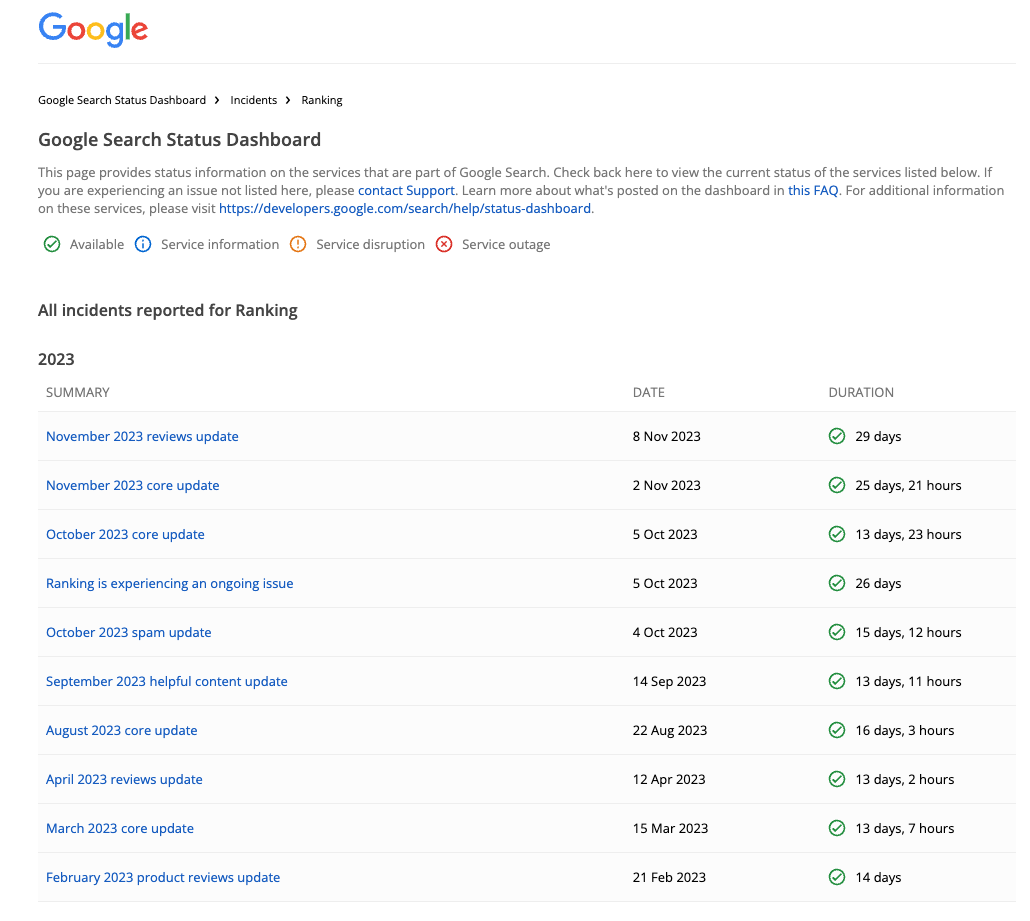What is Core Update and What Are the Considerations?
With the November 2023 core update, Google completed the year 2023 with its fifth large-scale core update. After this information, let's start reading our guide content on Core Updates.
What is Core Update?
Google Core Update refers to the significant changes Google has made to its search algorithm. These updates, usually made several times a year, are intended to improve the quality of search results. Core Updates can cause significant fluctuations in the search rankings of web pages, which has significant implications for SEO experts, web developers, and content producers.
In the case of a Core Update, Google's goal is to help users find the information they are looking for more quickly, and accurately and to improve the search experience overall. Algorithm updates include efforts to understand users' search intent better, reward high-quality content, and filter out low-quality content. By making changes to specific signals or factors, these updates can set new standards for ranking criteria for web pages.
Before and after announcing Core Updates, Google can provide webmasters and content creators with comprehensive guides. The guides often cover topics such as what types of content are preferred, what features are important for user experience, and how websites can be improved. However, it is difficult to determine what exactly has been changed after each update. This is because Google does not share the exact algorithm details for competitive reasons. In this way, the process of detailed examination of reports including published articles, outputs obtained from the sample, and sectoral Core Update reviews is a situation we frequently encounter in this period.

This can sometimes have negative consequences for websites, as Core Updates can affect the rankings of web pages. Sites that experience a drop in rankings need to understand which factors need to be reviewed to recover from the effects of the update. After the Core Update, SEO experts meticulously analyze what needs attention and potential strategies and develop comprehensive improvement plans. These plans can include technical SEO adjustments, content updates, and efforts to improve the user experience.
The Purpose of Core Updates and Google's Goal
Google's Core Updates serve the goal of providing a more accurate SERP for users and improving the user experience. Considering this purpose, we can say that the following items are generally among the main objectives of Core Updates.
- Improving User Experience: Improving the user experience by increasing the speed, usability, and accessibility of web pages. Mobile compatibility and page load times are examples of these criteria.
- Prioritizing High-Quality Content: Prioritizing content that is detailed, informative, and provides what users are looking for.
- Reducing Spam and Low Quality Content: Identifying content that has been manipulated with black hat SEO tactics and does not add value for users, and pulling them back in the rankings.
- Keeping the Algorithm Fair and Updated: Constantly updating the algorithm to reflect changes in the internet and user behavior.
What to Do After a Core Update?
After a Google Core Update is complete, website administrators and SEO experts can evaluate the performance of their sites by following these steps.
Examine Your Performance During the Update Period: First of all, we should examine your performance during the Core Update period. Close monitoring of the average positions on the Search Console will be beneficial. We can also closely monitor the positions of the keywords whose status is closely monitored here in the target countries. In a nutshell, analyze changes in traffic and ranking performance using tools like Google Analytics and Search Console here.

Review Google's Guidelines: Google usually releases a set of guidelines and recommendations with each update. We should carefully review these guidelines and focus on the areas highlighted by the update.
Improve Content Quality: Review and, if necessary, improve your content by the E-E-A-T (Experience, Expertise, Authority, Trustworthiness) principles. We can position the imprint, and relevant social media posts on the site to show the author's competence in this field.
Check Technical SEO Criteria: Improve user experience by optimizing technical SEO elements such as site speed, mobile compatibility, and internal link structure.
Evaluate User Feedback: By collecting feedback about users' experiences on the site, adjustments can be made to better respond to user needs.
In addition to this information, we do not recommend taking quick action and making drastic changes after the Core Update announcement. Because when Google announces a core update and states that it will take a few weeks to complete, you will have to wait at least a week until clear data is available. There may be nothing to report during this time. However, in this case, it would be the wrong strategy to wait and keep quiet until something concrete is reported. It would be one of the best methods to check your current situation and check compliance with Google guidelines without making serious changes here.
What to Do When Notifying Administrators of Google Updates
Google communicates Core Updates to webmasters and SEO professionals through several communication channels. These channels are important for close follow-up and a holistic approach.
Since core update periods can be uncertain, it is very important to manage the process. In these cases, when informing your management or stakeholders about core updates, it is important to provide information within the overall timing, goals, and possible context of the updates in the past.
When explaining the context of the updates, we can refer to the timeline and various themes of these updates. We can even link SEO to these themes against past updates or outcomes after updates. We should always use the announcement of the core update to drive the conversation about the SEO team's roadmap, work in progress, and expectations around the update.
When Google announces the update, we can send an email to managers to include the following:
- The date of the update and a link to Google's announcement.
- A statement that Google releases such broad kernel updates several times a year.
- How long the update is estimated to take (according to Google's statement).
- How the site has responded to the last one or two updates.
- Highlighting any work (technical, content, etc.) that may impact this update.
- We can emphasize that sometimes there are situations where we can report early movements, the current email is an awareness-oriented one.
In the middle of the update or when the first results are available, we should communicate information about the update via the same email. This communication will reinforce our work and keep managers updated on the situation. We can then start new conversations around performance.
When starting new conversations, I try to present the following topics:
- Restating the start and expected end date of the core update.
- Adding the statement that there are post-release actions after the update is complete.
- Clarification that there are actions and next steps after the update has been completed.
- Providing metrics showing the positive/negative impact of the update (including competitors tracked).
- The current situation in Core Update with visuals.
- Results of the projects on the site that the SEO team is working on.
- Including existing work that aligns with these themes and efforts in a process that can further improve performance with future updates.
- When the core update is complete, Google will announce it via Google Search Central and the Google Developers site.
In this way, we can deliver summary notifications with new results that support previous emails. It's worth mentioning here that Google's results are not clear after an update, and that there may be fluctuations in the SERP for a while, and we can add that additional fluctuations are expected over the next 1-2 weeks.
There may also be the following points that can be added as information:
- Showing which site segments showed positive or negative results.
- Differences between this update and previous updates.
- Work since the previous Core Update that may be in line with the positive results.
- Past findings or planned work that may have impacted negative results.
- Presenting the overall theme of the past few updates and findings on their impact on the site.
- The indication that email updates on key metrics such as traffic and revenue will continue to be provided.
At the same time, we can benefit from the following resources while following Core Updates.
- Search Console Announcements: Google Search Console provides important notifications and alerts for webmasters.
- Google Webmaster Blog: Official announcements and updated information are posted here.
- Social Media and SEO Communities: Google's official social media accounts and SEO communities post updated information and provide platforms for discussions.
To ensure communication and information flow, we should follow these sources regularly and we can manage the process by evaluating the updated information with the relevant teams and creating the necessary action plans.
This content was created by Mert Vahit Demir, SEO Manager at Zeo.















